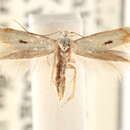Comprehensive Description
provided by Memoirs of the American Entomological Society
Elachista tanyopis Meyrick (.Figs. 91, 131.)
1932. Elachista tanyopis Meyrick, Exot. Microlep., iv, 218. Type <? , Parry Sound, Ontario, Canada [British Museum].
Head white tinged with ocherous in the darker specimens ; palpi white, second segment brownish gray outwardly; antennae ocherous-gray, basal segment white. Thorax whitish or ocherous tinged, slightly darker than the head. Fore wings whitish ocherous, with the costal margin near base dark brown; more or less dusted with brownish ocherous scales, which are densest in the costal area and toward the pair of pale spots at two-thirds and acutely produced between them, thus defining their inner margins ; an elongate black plical spot (stigma), the area before and beyond it sparsely or not at all dusted with darker scales. The pale spots at two-thirds are more or less obscured by dusting outwardly, the dorsal spot may have a group of darker scales at its outer margin. Cilia whitish ocherous, the marginal scales forming a dark line through them, which is broken on costa at apex by a white bar (more or less distinct) which may extend as a gradually narrowing white streak along the termen toward
tornus. Hind wings gray, contrasting by their dark color with the fore wings ; cilia brownish, pale at bases. Underside of both pair of wings dark brown. Fore and middle legs mostly dark brown, hind legs whitish ocherous, with some dark shading faintly defining the usual pale bars and tips of segments. Abdomen brownish gray, with the terminal segments and underside whitish ocherous.
Alar expanse: 9 to 10 mm.
Male genitalia (fig. 91 ) : uncus lobes with rather short curved setae ; gnathos, two elliptical spined knobs ; cucullus of harpe terminating apically in a strong spine, costal apical area semicircular, free process of harpe short, sacculus basally with a large circular depression fringed distally with inwardly directed hairs, sacculus processes broad at base and little widening outwardly, somewhat truncate viewed laterally ; anellus lobes diverging, apex rounded with a few short setae ; vinculum triangular ; aedeagus tapering, cornutus a short spine arising from a greatly elongated sclerotized base.
Female genitalia (fig. 131) : ovipositor lobes small and rounded; dilated part of ductus bursae before ostium deeply cup-shaped, sides straight, spinulate; ductus bursae sclerotized to the middle of the long segment 7; bursa copulatrix bulging to the right, smooth, signum a dentate knife-like ridge on a sclerotized diamond-shaped base.
Specimens examined: 10 8, 1 9.
Ontario: Bobcaygeon, 5 $, 22-VI-31 (3 specimens), 15-VI-31, 17-YI-'31 (J. McDunnough), [C. N. Coll.].
Maine: Alton, 2 S, 1 2, June 28, 1938; 1 $, Southwest Harbor, July 5, 1937; Bangor, 1 S, June 24, 1938 (E. A. Brower), [A. N. S. P.].
New Jersey: Whitesbog, 1 $ , at light, June 22, 1940 (E. P. Darlington), Food plant and early stages unknown, but the larva is probably a miner of some species of sedge or rush.
E. tanyopis is allied to the western salinaris Braun and to the European rhynchosporella Stainton, with which it agrees closely in characters of the genitalia. It is the only eastern North American species of Elachista in which the cucullus of harpe terminates in a spine, a character observable in the dry specimen. The contrastingly dark hind wings and different venation separate the palest specimens from any of the white species with dark plical spot.
- bibliographic citation
- Braun, A.F. 1948. Elachistidae of North America (Microlepidoptera). Memoirs of the American Entomological Society vol. 13. Philadelphia, USA

